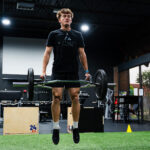Mobility Matters in Sports Performance Training
Mobility is the foundation for every athletic movement. Whether you’re sprinting, jumping, or changing direction, you need a full range of motion to perform at your best. That’s why incorporating mobility into sports performance training is essential for every athlete.
In this article, we’ll explore what mobility really is, why it matters, and the best ways to improve it for peak performance.
What Is Mobility?
Mobility refers to how well your joints move through their full range of motion. It’s different from flexibility, which is more about muscle length.
You need mobility to:
-
Squat deeply without pain
-
Rotate through your spine during a throw
-
Raise your arms overhead for a rebound
-
Move fluidly and powerfully during sport
Poor mobility can limit performance and increase injury risk.
Why Athletes Need Mobility Training
Many athletes focus on speed and strength—but forget that those skills rely on good mobility.
Benefits of mobility-focused sports performance training include:
-
Injury prevention: Avoid pulls, tears, and joint issues
-
Improved performance: Move more freely and efficiently
-
Better posture: Prevent compensation and fatigue
-
Quicker recovery: Reduce soreness and stiffness
-
More power: Move through full ranges for greater force output
Tight hips, ankles, and shoulders can rob you of speed, agility, and strength.
Top Mobility Areas for Athletes
Here are the key joints and muscle groups athletes need to focus on:
1. Hips
Tight hip flexors limit sprinting and cutting ability. Open up your hips for longer strides and quicker changes of direction.
2. Ankles
Stiff ankles affect running, jumping, and squatting. Better ankle mobility improves balance and reduces knee strain.
3. Shoulders
Overhead movements require flexible shoulders. Good mobility prevents rotator cuff injuries and improves upper-body power.
4. Thoracic Spine (Mid-Back)
This area supports rotation and posture. Mobile spines reduce stress on the lower back and shoulders.
5. Hamstrings and Calves
These muscles drive sprinting and jumping. Flexible hamstrings prevent pulls and improve stride mechanics.
Best Mobility Drills for Sports Performance
Add these to your warm-up or recovery routine 3–5 times per week.
1. World’s Greatest Stretch
How to do it: Start in a lunge, rotate your torso toward the front leg, and reach your arm to the ceiling.
Targets: Hips, thoracic spine, and hamstrings.
2. 90/90 Hip Switches
How to do it: Sit on the ground with one leg in front (90°) and one behind. Switch sides while keeping posture tall.
Targets: Hip internal and external rotation.
3. Ankle Rocks
How to do it: Stand or kneel and rock your knee over your foot while keeping your heel down.
Targets: Ankle dorsiflexion and Achilles tendon.
4. Foam Rolling
How to do it: Roll slowly over tight muscles like calves, quads, glutes, and back. Spend 30–60 seconds per area.
Targets: Muscle tension and trigger points.
5. Cat-Cow Stretch
How to do it: On hands and knees, alternate arching and rounding your spine.
Targets: Spine mobility and posture.
Sample Daily Mobility Routine
Spend just 10–15 minutes daily to improve joint movement:
| Exercise | Reps/Duration |
|---|---|
| World’s Greatest Stretch | 3 per side |
| Ankle Rocks | 10 per leg |
| 90/90 Hip Switches | 10 total |
| Foam Roll (Quads + Back) | 60 sec per area |
| Cat-Cow Stretch | 10 rounds |
Perform this before or after practice for best results.
Sports Performance Training and Mobility: A Perfect Match
When your joints move well, your body can use its full potential. That’s why top programs like Next Level Athletics combine strength, speed, and mobility work in their training.
Mobility should never be an afterthought—it’s a key component of athletic development.
Mobility Mistakes to Avoid
Don’t fall into these common traps when working on mobility:
-
Only stretching: Mobility includes joint movement and control, not just passive stretching
-
No consistency: Once a week isn’t enough—make it part of your routine
-
Pushing through pain: Mobility should feel challenging but not painful
-
Ignoring warm-ups: Always prep your body before intense movement
-
Skipping tight areas: Don’t avoid the uncomfortable spots—those need the most attention
Mobility is maintenance for your athletic engine. Don’t skip it.
Recovery and Mobility Work Together
Tightness and soreness reduce performance. Use these tips to enhance recovery:
-
Hydrate well to prevent cramping
-
Stretch lightly after training
-
Use massage or compression tools to increase circulation
-
Get quality sleep for tissue repair
-
Breathe deeply during mobility work to release tension
Mobility boosts your recovery, and recovery boosts your performance.
Nutrition for Joint Health
Support your mobility gains with the right fuel:
-
Omega-3s (from fish or flaxseed) reduce inflammation
-
Collagen and gelatin help build joint tissue
-
Vitamin C supports collagen production
-
Water keeps tissues hydrated and pliable
Stay mobile from the inside out.
Conclusion: Mobility Unlocks Potential
Every athlete wants to be faster, stronger, and more explosive. But none of that matters if tight joints hold you back.
Mobility is the secret weapon of high-level sports performance training. With just a few minutes a day, you can prevent injuries, improve movement, and extend your athletic career.
Start now, stay consistent, and move better every time you compete.


Recent Comments